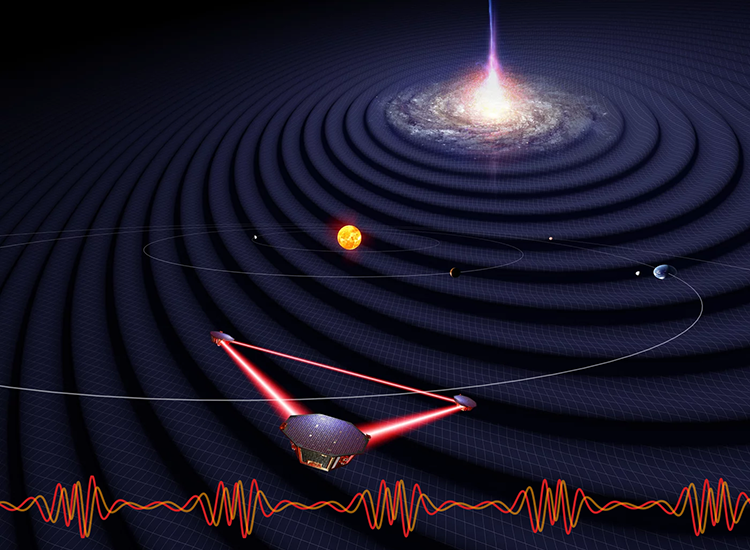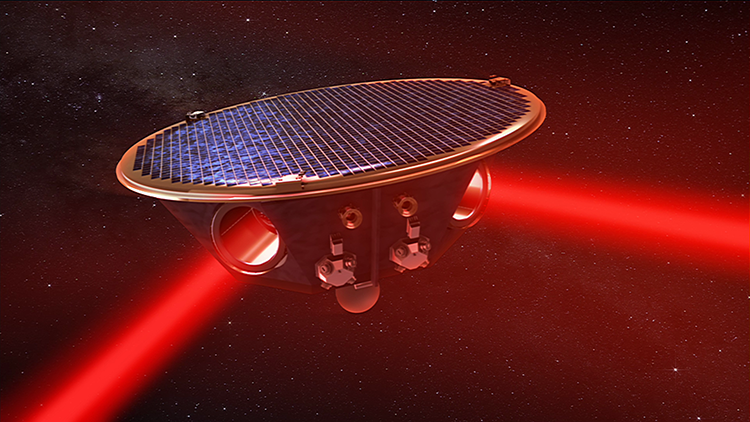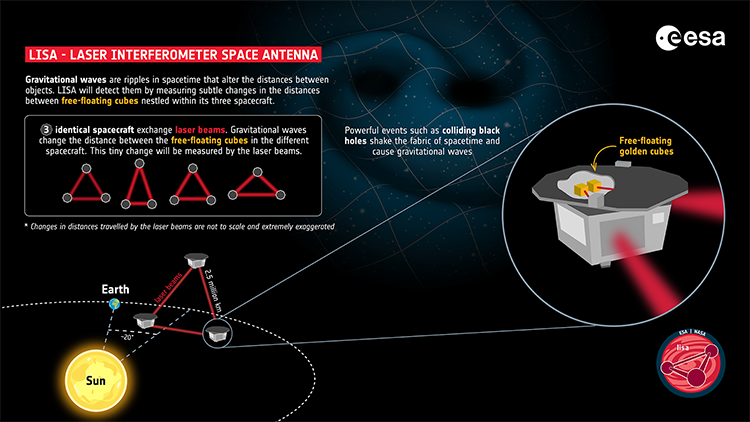UCD Relativity Group plays key role in first ever gravitational-wave observatory in space
Posted 25 January 2024

Researchers from the UCD School of Mathematics and Statistics are behind the European Space Agency’s plan to unravel the mysteries of gravitational waves with the first ever orbital observatory designed to study the ripples in space and time caused by the motion of black holes.
(opens in a new window)The Laser Interferometer Space Antenna (LISA) mission, the first scientific endeavour to detect gravitational waves from space, has been approved by the ESA’s Science Programme Committee.
This formal adoption of the project means that its mission concept and technology are sufficiently advanced to be greenlit for the construction of its instruments and spacecraft.
Led by ESA, the LISA Mission is a collaboration between the ESA, NASA, the space agencies of EU member states, and the (opens in a new window)LISA consortium - an international team of scientists working together to bring the project to fruition.

The LISA Mission will fire lasers between the satellites to measure how gravitational waves alter their relative distances
The LISA mission will measure ripples in space and time that come from the motion of black holes and other sources, and a key ingredient required to understand these signals will be the precise theoretical models of gravitational waves that have been developed by the (opens in a new window)Relativity Group at the UCD School of Mathematics and Statistics.
“This is a big day for the (opens in a new window)UCD Relativity Group. We have been working for decades to understand the motion of black holes. The models we are developing will be a key ingredient in the scientific discoveries of the LISA mission,” said (opens in a new window)Dr Niels Warburton, a group leader for the UCD Relativity Group, and co-chair of the LISA Consortium Waveform Working Group.
Just over a century ago, Einstein predicted that when massive objects accelerate, they shake the fabric of spacetime, producing miniscule ripples known as gravitational waves.
The UCD Relativity group uses Einstein’s theory of General Relativity to study black holes and other sources of gravitational waves, and by comparing the theoretical models that they have developed with the data collected by LISA, scientists from around the world will be able to probe the properties of galactic centers throughout the lifetime of the universe, as well as testing the limits of Einstein’s theory of gravity (General Relativity) and much more.
Breaking space science news
— ESA (@esa) (opens in a new window)January 25, 2024
We have adopted two new ambitious space science missions:
EnVision: a bold mission to study Venus from its inner core to its outer atmosphere, giving important new insight into the planet's history, geological activity and climate targeted to… (opens in a new window)pic.twitter.com/VIjSBziVtH
“LISA is an endeavour that has never been tried before. Using laser beams over distances of several kilometres, ground-based instrumentation can detect gravitational waves coming from events involving star-sized objects – such as supernova explosions or merging of hyper-dense stars and stellar-mass black holes. To expand the frontier of gravitational studies we must go to space,” said LISA project lead Nora Lützgendorf, an astrophysicist working for the ESA.
“Thanks to the huge distance travelled by the laser signals on LISA, and the superb stability of its instrumentation, we will probe gravitational waves of lower frequencies than is possible on Earth, uncovering events of a different scale, all the way back to the dawn of time.”
Not just a single spacecraft but a constellation of three, the orbiting gravitational-wave detector will trail the Earth around the Sun in the pattern of an equilateral triangle that is 2.5 million km long, more than six times the distance between the Earth and the Moon. Each spacecraft will exchange laser beams over this distance. The launch of the three spacecraft is planned for 2035, on an Ariane 6 rocket.
LISA will detect, across the entire Universe, the ripples in spacetime caused by black holes. This will enable scientists to trace the origin of these monstrous objects, to chart how they grow to be millions of times more massive than the Sun and to establish the role they play in the evolution of galaxies.
The mission is poised to capture a direct glimpse into the very first seconds after the Big Bang.

The launch of the LISA Mission is planned for 2035
“With the adoption decision, LISA is now firmly established in ESA’s programme of missions. We are looking forward to realising LISA in a close collaboration of ESA, NASA, ESA member states and the wider LISA Consortium” said Karsten Danzmann, Lead of the LISA Consortium, Max Planck Institute for Gravitational Physics and Leibniz University Hannover.
“This trailblazing mission will take us to the next level in a really exciting area of space science and keep European scientists at the forefront of gravitational wave research,” added Carole Mundell, ESA Director of Science Carole Mundell.
The UCD Relativity Group are full members of the LISA consortium, and will host over 300 international researchers at the (opens in a new window)biennial LISA Symposium at UCD this summer.
By: David Kearns, Digital Journalist / Media Officer, UCD University Relations
To contact the UCD News & Content Team, email: newsdesk@ucd.ie






